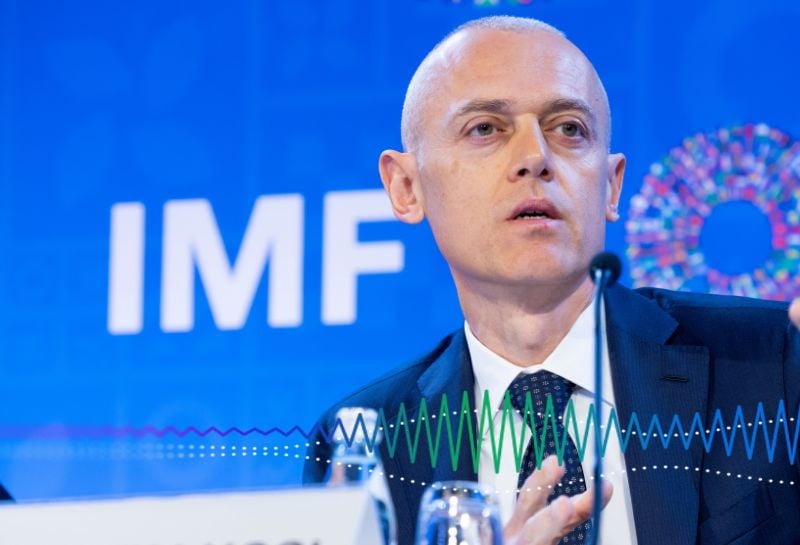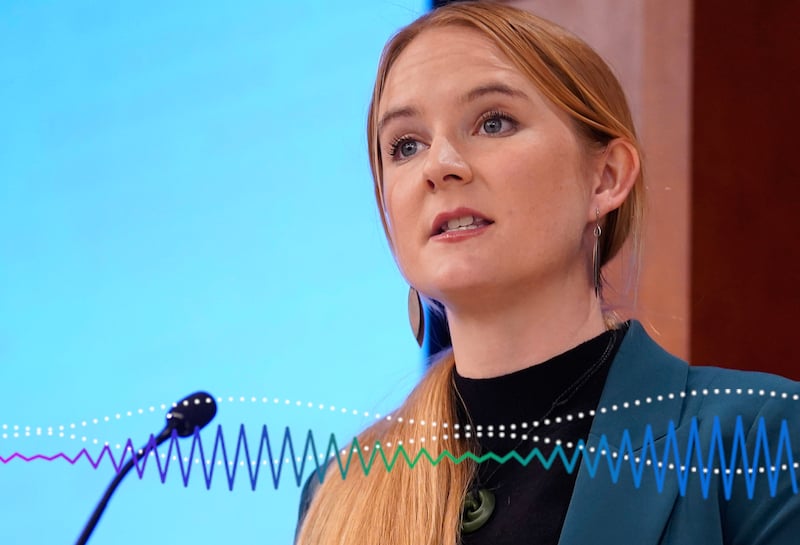
Financial Stability / Financial markets
Global Financial Stability Tested by Higher Inflation and Interest Rates
In This Episode
Financial stability never comes easy, but the past few months have been especially challenging with persistently high inflation and two bank failures in the United States that exposed vulnerabilities lurking beneath the surface. The latest Global Financial Stability Report (GFSR) examines all the worrying trends including the potential economic impact of rising geopolitical tensions. Fabio Natalucci heads the GFSR. In this podcast, he says while regulatory changes put in place after the Global Financial Crisis have made the financial system more resilient, recent events may be a harbinger of more systemic stress to come.
Fabio Natalucci: Financial fragmentation induced by geopolitical tensions could have important implications for financial stability by affecting cross-border allocation of capital, international payment systems, and asset prices.
Bruce Edwards: Financial stability never comes easy, but the past few months have been especially challenging with persistently high inflation and a couple of bank failures that exposed vulnerabilities lurking beneath the surface. The latest Global Financial Stability Report examines all the worrying trends, and they're not all strictly economic. The report shows even the smallest increase in geopolitical tensions between investing and recipient countries can have a big impact
Fabio Natalucci: That could reduce bilateral cross-border portfolio and bank allocation by about 15%. My name is Fabio Natalucci. I'm a Deputy Director in the Monetary and Capital Markets Departments of the IMF. I'm responsible for the Global Financial Stability Report, the GFSR, which is one of the flagships of the IMF, as well as for the broader global financial markets monitoring.
Bruce Edwards: Great. Thank you so much and welcome back to the podcast. So we speak basically twice a year, and up until last spring or, I guess maybe a little earlier for some regions, we were pretty much always talking about the risks associated with investors looking for yield in a lowinterest rate environment, which resulted in some very strong market activity for a very long time. We're now seeing a dramatic change on many levels. So are we paying the price for all those years of super low rates?
Fabio Natalucci: So in the aftermath of the Global Financial Crisis, in an environment that had extremely low-interest rates, compressed volatility, very ample liquidity, market participants increased their exposures to a number of risks. Liquidity, duration, credit risk, and often they used financial leverage to boost returns, expected returns. Now, these vulnerabilities have kept the financial stability risk elevated. A number of these vulnerabilities have been flagged in previous issues of the global financial stability report in the past few years. Now, these vulnerabilities have been exposed in the current high-inflation environment, with central banks tightening monetary policy and removing liquidity aggressively to bring inflation back to target. Now, with the disinflationary pressures going slower than anticipated, the rapid pace of policy tightening, and again, I wanna stress the word rapid pace, it's not just the level of where central banks are taking policy rates, but also the pace of the tightening is causing fundamental shifts in the financial risk landscape. So asset allocation, asset prices, and market conditions are all adjusting, challenging market structures, and challenging investors and financial institutions. And what we see is the emergence of a number of pressure points in the global financial system.
Bruce Edwards: And so we saw two US banks fail last month, SVB and Signature Bank. How did those two US bank failures turn so quickly into a global financial issue? And what does it tell us about the current state of the banking sector more broadly?
Fabio Natalucci: So the sudden failure of these two banks, Silicon Valley Bank and Signature Bank in New York, those were two mid size banks in the US as well, as importantly, I think we want to point out the loss of confidence Credit Suisse, that's a globally systemically important bank in Europe. I think those are powerful reminders of the challenges faced by the interaction between tighter monetary and financial conditions and the build-up of these vulnerabilities. Part of it also has been amplified by new technology. So the rapid spread of information through social media. So what in the US initially looked like an isolated event or a couple of events in the banking sector quickly spread to banks, financial markets across the world. They have caused a sharp reprising of interest rate expectations and a dramatic sell-off of risk assets. Now there's been a very forceful response by policymakers to stem systemic risk and reduce market anxiety. Um, now despite some of these improvements of late, uh, we have seen some asset prices recovering the losses back then, more than recovering actually, but market sentiment still remains fragile. And there are still strains evident across a number of institutions and markets. So I think it remains to be seen whether the measures that have been taken so far have been sufficient to restore confidence in the markets. Now you ask about banking. Again, this has been another reminder that funding can disappear very rapidly. And even that event as small banks or what they appear to be small banks, can have systemic implications if they trigger widespread loss of confidence and fears that spread very quickly across the system, again, amplified by technology and, and social media. The issue here is that there've been a shifting pattern of deposits across institutions, they could raise funding for banks that could restrict the ability to provide credit down the road considering the banks were already tightening lending standards going into this episode.
Bruce Edwards: And, the fact that non-bank financial institutions have become more integrated into the banking system over the years, how does that play into this scenario?
Fabio Natalucci: So the, what we call NFBIs, or Non-Bank Financial Intermediaries, they play a key role in the global financial system. They increase access to credit, they support economic growth, but they have financial vulnerabilities that have been increasing in recent years when rates are very low. Particularly, we point to elevated leverage, liquidity mismatch, and high level of interconnectedness between the banking sector and the non-banking sector. Now, there's been a number of stress events growing into this. The most recent one, if you go back a year or so, they have required aggressive intervention by policymakers. So you can take the United Kingdom, for example. There was forced selling by pension funds in the fall that required targeted temporary purchases by the Bank of England to stabilize the sovereign debt markets. Or if you look at Korea, authorities had to deploy a slew of tools, including reusing some of the covid era asset purchase programs to address strains in what's called the asset-backed commercial paper in October 2022. The common thread, I think, across all these events is a combination of vulnerabilities. So liquidity, maturity, mismatched financial leverage, interconnectedness, they have been lurking under the surface of the global financial system for years and market participants honestly fail to adequately prepare for rate increases sometimes, so possible disruption in funding markets, and also links across the financial system. So what's obvious now in inside, the systemic implications of the existing weaknesses, I think were generally unanticipated in the financial system. And so when the risk materialized, the systemic implications have become clear and they have required immediate policy intervention by policymakers.
Bruce Edwards: And so what about emerging markets? I mean are they exposed to the same risks as advanced economies? I know the report suggests that the global financial system may well be exposed to weaknesses there.
Fabio Natalucci: Yeah. So what, let me make a point about banks, why it's important to look at banks, and we try to do it with the US and then I'll link it back to the EMs. So the focus in the US is about essentially what we call regional banks. These banks have a deposit, concentrated deposit base. They have high exposure in duration risk. And this is what we have seen in there has been systemic. They will be greater scrutiny in terms of holdings and expectations by market participants. They would be subject to more stringent supervision regulations. Now, what we're trying to do, we do a little exercise in the GFSR, where we're trying to map the decline in bank equity prices to the lending capacity of these banks and showing that given where bank equity prices were at the close of the report, that means that declining lending capacity of about one percentage point in the coming year, that we could bring back the global, real GDP for the US by about 50 basis points. So my point is, tightening standards has implications for lending capacity and for growth. Now, why does it matter in emerging markets? I think in emerging markets it's important because banks play a larger role in the financial system compared to more advanced economies. So if there is weakness in the banking sector, that likely would have a bigger impact in terms of growth. Now, emerging markets appear so far to avoided the pressure that we have seen in advanced economies. They generally have less exposure to interest rate risk. They have a lower share of market-to-market securities. They have a higher share of funding through retail deposits. They're less flighty. Now that said, a number of countries do have low deposits, low levels of deposit insurance coverage in case there is a run, and many sovereigns also have less fiscal and monetary space to address problems in the banking sector should such problems arise. And so finally, they also have assets with lower asset asset quality than those in advanced economies. So that suggests if there is a deterioration of confidence in the banking sector, that could have an impact on that profit profitability of the banks.
Bruce Edwards: And so where do central banks stand in all this? Given the rates had a lot to do with those two banks that we spoke of earlier failing. Do central banks now have the jitters? And how might that influence their approach to fighting inflation, which is still a problem,
Fabio Natalucci: So the emergence of stress in financial markets is complicating the task of central banks. Particularly at a time when inflationary pressures seem to be more persistent than anticipated or hoped for. Now, prior to this stress episode, interest rates in advanced economies were rising sharply. And there was the gap essentially between market pricing and central bank communication was shrinking, particularly the communication about the need to keep monetary policy restricted for longer. However, after these episodes and distress episodes, the path to policies moved lower. And so now investors anticipated central banks to actually begin to ease monetary policy well in advance of what was priced in, but unfortunately, inflation remains uncomfortably high, well above target. So how to deal with this. The availability of tools aimed at addressing financial stability risks should help central banks separate monetary policy objectives from financial stability goals. So allowing them effectively to continue to tighten monetary policy and address inflationary pressure. If financial pressure intensifies though significantly and threatens the health of the financial system amid high inflation, then tradeoffs between financial stability and inflation could emerge. And so clear communication about central bank objectives would be crucial to minimize uncertainty. Obviously, central banks should act swiftly to prevent any systemic event that could shake confidence in the system because confidence is the core of the financial sector. So you need to take every step possible to do that. But should they need to adjust the strength of monetary policy to support financial stability, it's very important that central banks clearly communicate the continued resolve to bring inflation back to target as soon as possible once financial stress lessens.
Bruce Edwards: Okay, so the report also looks at how geopolitical tensions and an increasingly fragmented world are, are posing additional risks to the financial system. What are the concerns there?
Fabio Natalucci: So the report points to a number of downside risks to the global economy. And those risks remain elevated. Apart from stress, financial stress, there are other possible sources of macroeconomic risk that could have macrofinancial implications. Escalation of war in Ukraine, sharp rebound of activity in China that pushes up energy prices again at a time when inflation is high. And then we look at rising geopolitical tensions that could result in financial fragmentation causing sudden reverse in cross border capital flows, particularly for emerging markets and exaggerate financial stability. Now, how do we look at this? I think the idea is that financial fragmentation induced by geopolitical tensions could have important implications for financial stability by affecting cross-border allocation of capital, international payment systems and asset prices. Essentially, if you look at geopolitical tensions, we run a little exercise and we show that one standard deviation increase in geopolitical tensions between investing and recipient country. That's more or less the diverging voting pattern, for example, between the US and China in the United Nations in 2016, that could reduce bilateral cross-border portfolio bank allocation of about 15%. That's not a small number. It could also cause a sudden reversal of cross-border capital flows and this effect would be more pronounced for emerging markets and European economies. How that links to financial stability, this is because that sort of shock could in fact increase bank's funding costs, reducing profitability, lowering the provision of credit to the private sector. And again, this is likely to be larger, particularly for banks that have lower capitalization. And so finally there is also more long-term impact because if you have greater financial fragmentation related to geopolitical tension in the long-term, the benefits from reducing international risk diversification opportunities could actually have an impact on growth.
Bruce Edwards: So how do you see this playing out in the coming months? I mean, do you think that the dust will settle or is this just a taste of what's the come?
Fabio Natalucci: I think it's the fundamental question now that's confronting both market participants and policymakers. It's whether this recent events are a harbinger of more financial systemic risk to come down the road, testing the results of the global financial system. Sort of like a canary in the coal mine. Or just the isolated manifestation of challenges, almost like the natural manifestation of challenges from tighter monitoring of financial conditions after more than 10 years of low rates and volatility. Now to be clear, there is little doubt that regulatory changes that have been implemented since the global financial crisis, particularly for the largest banks, have made the financial system generally more resilient. But there are still concerns about vulnerabilities that may be hidden I mentioned some of those. And in fact, investors appear to be looking for stress problems, for fragilities, including links as we discussed between the banking sector and the non-bank financial intermediation sector that may have been underestimated or missed. Now, the issues that exposure losses can be masked for a while because of accounting rules that we have seen for the banks in California, regulatory treatment, other factors that maybe requires some assets to be valued not on market value or because are hidden in some corner of the financial system that are more opaque or less visible. But those exposure and losses do not disappear. Losses related to those exposures need to be allocated somewhere in the financial system. And so complacency in addressing them tends to be an amplifier of market stress once they get realized. If I may, one sector that we are looking at, particularly that it's a little bit at the crossroads between the banking and non-bank financial sector, is the commercial real estate market. This has been covered in previous Global Financial Stability Reports. I think you and I also have discussed that. And that sector is under pressure from a combination of factors. One is a worsening of fundamentals. So structural issues post-pandemic shifts in office and real estate demand, but also from tighter funding costs as a result of the financial stress. For example, in the US banks with more than 250 billion account for about three-quarters of commercial real estate bank lending. So a deterioration of asset quality would have significant repercussions for those banks. And then in addition, NBFI play an important role both in terms of real estate investment trust rates as well as the commercial market bank securities, which has a broad set of investors in the sector. So that stress in the sector would have broad implications for financial stability and economic growth.
Bruce Edwards: Well, no lack for risks in this Global Financial Stability Report. Fabio Natalucci is the head of that report, that comes out twice a year. Always a pleasure. Fabio, thank you.
Fabio Natalucci: Thank you very much.
Bruce Edwards: Fabio Natalucci is Deputy Director in the Monetary and Capital Markets Department. Look for the latest Global Financial Stability Report at IMF.org/GFSR. And look for other IMF podcasts wherever you listen. You can also follow us on Twitter @IMF_podcast. I'm Bruce Edwards. Thanks for listening.
Join Us on Every Major Platform
Latest Podcasts
BEHIND THE MIC

Bruce Edwards
International Monetary Fund
Bruce Edwards produces the IMF podcast program. He's an award-winning audio producer and journalist who's covered armed conflicts, social unrest, and natural disasters from all corners of the world. He believes economists have an important role in solving the world's problems and aspires to showcase their research in every IMF podcast.

Rhoda Metcalfe
RHODA METCALFE is an independent journalist and audio producer.











